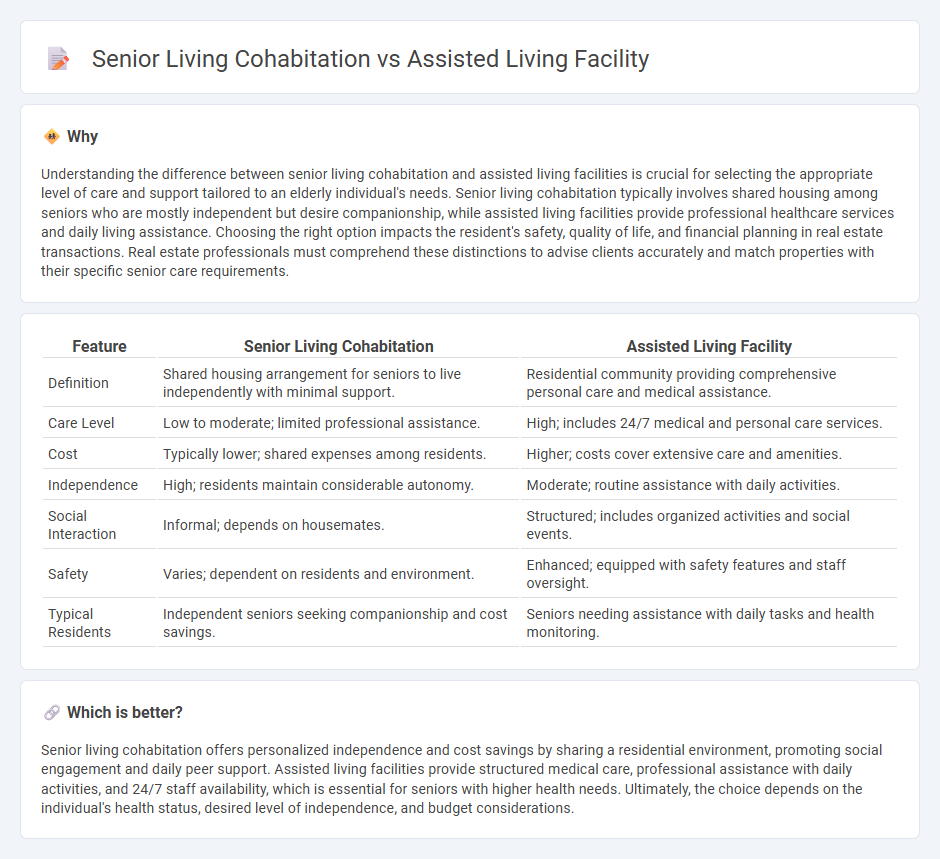
Senior living cohabitation offers a cost-effective and socially engaging alternative to traditional assisted living facilities, emphasizing shared living spaces and mutual support among residents. Assisted living facilities provide comprehensive medical care, personalized assistance, and professional staff to address the complex needs of seniors requiring daily support. Explore the benefits and distinctions between these senior living options to find the ideal environment for aging comfortably and safely.
Why it is important
Understanding the difference between senior living cohabitation and assisted living facilities is crucial for selecting the appropriate level of care and support tailored to an elderly individual's needs. Senior living cohabitation typically involves shared housing among seniors who are mostly independent but desire companionship, while assisted living facilities provide professional healthcare services and daily living assistance. Choosing the right option impacts the resident's safety, quality of life, and financial planning in real estate transactions. Real estate professionals must comprehend these distinctions to advise clients accurately and match properties with their specific senior care requirements.
Comparison Table
| Feature | Senior Living Cohabitation | Assisted Living Facility |
|---|---|---|
| Definition | Shared housing arrangement for seniors to live independently with minimal support. | Residential community providing comprehensive personal care and medical assistance. |
| Care Level | Low to moderate; limited professional assistance. | High; includes 24/7 medical and personal care services. |
| Cost | Typically lower; shared expenses among residents. | Higher; costs cover extensive care and amenities. |
| Independence | High; residents maintain considerable autonomy. | Moderate; routine assistance with daily activities. |
| Social Interaction | Informal; depends on housemates. | Structured; includes organized activities and social events. |
| Safety | Varies; dependent on residents and environment. | Enhanced; equipped with safety features and staff oversight. |
| Typical Residents | Independent seniors seeking companionship and cost savings. | Seniors needing assistance with daily tasks and health monitoring. |
Which is better?
Senior living cohabitation offers personalized independence and cost savings by sharing a residential environment, promoting social engagement and daily peer support. Assisted living facilities provide structured medical care, professional assistance with daily activities, and 24/7 staff availability, which is essential for seniors with higher health needs. Ultimately, the choice depends on the individual's health status, desired level of independence, and budget considerations.
Connection
Senior living cohabitation and assisted living facilities both address the housing and care needs of elderly individuals seeking supportive environments. Assisted living facilities provide professional healthcare services and daily assistance, while senior living cohabitation offers a shared, home-like setting fostering social interaction and independence. Both options enhance quality of life by promoting safety, companionship, and tailored support for aging adults.
Key Terms
Care Services
Assisted living facilities provide structured care services tailored to seniors needing help with daily activities such as medication management, personal hygiene, and mobility support, often available 24/7. Senior living cohabitation models emphasize shared living spaces with less intensive care, promoting independence and social interaction while offering minimal assistance. Explore further to understand which care service model aligns best with your senior living preferences.
Independence Level
Assisted living facilities provide structured support and medical assistance tailored to seniors requiring daily help with activities, ensuring safety and health management. Senior living cohabitation emphasizes fostering independence by offering shared living spaces where residents maintain personal autonomy while benefiting from a community environment. Explore options to determine which setting best aligns with your desired level of independence and care needs.
Shared Housing
Assisted living facilities provide professional healthcare support and personal care services in a structured environment, whereas senior living cohabitation, especially shared housing, emphasizes communal living with shared responsibilities and social interaction among residents. Shared housing in senior cohabitation offers a cost-effective alternative fostering independence and companionship, with less formal medical support than assisted living. Discover how shared housing can enhance quality of life for seniors seeking community and affordability.
Source and External Links
Assisted Living: What Caregivers Need to Know - Assisted living facilities provide support for older adults who need help with daily activities but aim to maximize independence.
Assisted living - Assisted living residences offer a housing environment for people who cannot or choose not to live independently, providing various care options.
Residential Assisted Living Facilities (RALF) - RALFs provide necessary supervision, personal assistance, and lodging for adults with minimal needs for daily living and care.
 dowidth.com
dowidth.com